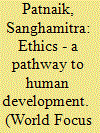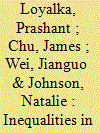| Srl | Item |
| 1 |
ID:
145917


|
|
|
|
|
| Summary/Abstract |
Human Development revolves around three key words – capability, growth and participation. It believes in widening human capabilities through the development of human resources. It also implies that the benefits of growth must be translated into the lives of people. It emphasizes that people must be able to participate actively in influencing the processes that shape their lives. Thus, participation of the people in the decision-making process ensures empowerment and growth. Power according to Gandhiji gets expanded when it is shared with others. The base of his ethics of power is very much dependent on who exercises it. Here, power is derived from the people and should be used for people’s welfare.
|
|
|
|
|
|
|
|
|
|
|
|
|
|
|
|
| 2 |
ID:
151582


|
|
|
|
|
| Summary/Abstract |
Inequalities in college access are a major concern for policymakers in both developed and developing countries. Policymakers in China have largely tried to address these inequalities by helping disadvantaged students successfully transition from high school to college. However, they have paid less attention to the possibility that inequalities in college access may also arise earlier in the pathway to college. The purpose of this paper is to understand where inequalities emerge along the pathway to college in China, focusing on three major milestones after junior high. By analysing administrative data on over 300,000 students from one region of China, we find that the largest inequalities in college access emerge at the first post-compulsory milestone along the pathway to college: when students transition from junior high to high school. In particular, only 60 per cent of students from poor counties take the high school entrance exam (compared to nearly 100 per cent of students from non-poor counties). Furthermore, students from poor counties are about one and a half times less likely to attend academic high school and elite academic high school than students from non-poor counties.
|
|
|
|
|
|
|
|
|
|
|
|
|
|
|
|
| 3 |
ID:
168673


|
|
|
|
|
| Summary/Abstract |
Nationally Determined Contributions (NDCs) submitted so far under the Paris Agreement are not in line with its long-term temperature goal. To bridge this gap, countries are required to provide regular updates and enhancements of their long-term targets and strategies, based on scientific assessments.
|
|
|
|
|
|
|
|
|
|
|
|
|
|
|
|